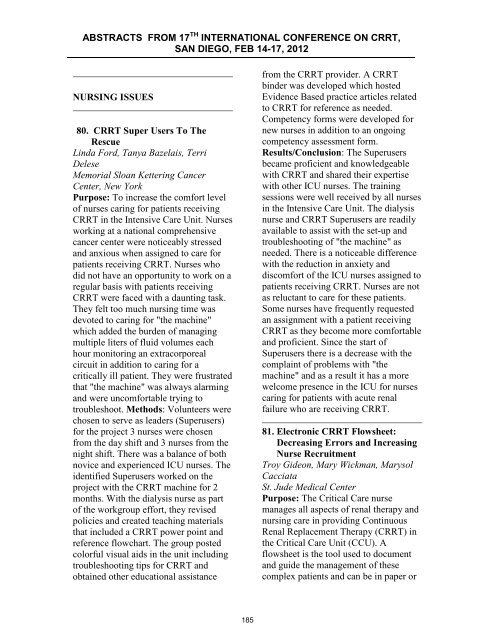ABSTRACTS from 16th International COnference on ... - CRRT Online
ABSTRACTS from 16th International COnference on ... - CRRT Online
ABSTRACTS from 16th International COnference on ... - CRRT Online
Create successful ePaper yourself
Turn your PDF publications into a flip-book with our unique Google optimized e-Paper software.
<str<strong>on</strong>g>ABSTRACTS</str<strong>on</strong>g> FROM 17 TH INTERNATIONAL CONFERENCE ON <strong>CRRT</strong>,<br />
SAN DIEGO, FEB 14-17, 2012<br />
NURSING ISSUES<br />
80. <strong>CRRT</strong> Super Users To The<br />
Rescue<br />
Linda Ford, Tanya Bazelais, Terri<br />
Delese<br />
Memorial Sloan Kettering Cancer<br />
Center, New York<br />
Purpose: To increase the comfort level<br />
of nurses caring for patients receiving<br />
<strong>CRRT</strong> in the Intensive Care Unit. Nurses<br />
working at a nati<strong>on</strong>al comprehensive<br />
cancer center were noticeably stressed<br />
and anxious when assigned to care for<br />
patients receiving <strong>CRRT</strong>. Nurses who<br />
did not have an opportunity to work <strong>on</strong> a<br />
regular basis with patients receiving<br />
<strong>CRRT</strong> were faced with a daunting task.<br />
They felt too much nursing time was<br />
devoted to caring for "the machine"<br />
which added the burden of managing<br />
multiple liters of fluid volumes each<br />
hour m<strong>on</strong>itoring an extracorporeal<br />
circuit in additi<strong>on</strong> to caring for a<br />
critically ill patient. They were frustrated<br />
that "the machine" was always alarming<br />
and were uncomfortable trying to<br />
troubleshoot. Methods: Volunteers were<br />
chosen to serve as leaders (Superusers)<br />
for the project 3 nurses were chosen<br />
<str<strong>on</strong>g>from</str<strong>on</strong>g> the day shift and 3 nurses <str<strong>on</strong>g>from</str<strong>on</strong>g> the<br />
night shift. There was a balance of both<br />
novice and experienced ICU nurses. The<br />
identified Superusers worked <strong>on</strong> the<br />
project with the <strong>CRRT</strong> machine for 2<br />
m<strong>on</strong>ths. With the dialysis nurse as part<br />
of the workgroup effort, they revised<br />
policies and created teaching materials<br />
that included a <strong>CRRT</strong> power point and<br />
reference flowchart. The group posted<br />
colorful visual aids in the unit including<br />
troubleshooting tips for <strong>CRRT</strong> and<br />
obtained other educati<strong>on</strong>al assistance<br />
<str<strong>on</strong>g>from</str<strong>on</strong>g> the <strong>CRRT</strong> provider. A <strong>CRRT</strong><br />
binder was developed which hosted<br />
Evidence Based practice articles related<br />
to <strong>CRRT</strong> for reference as needed.<br />
Competency forms were developed for<br />
new nurses in additi<strong>on</strong> to an <strong>on</strong>going<br />
competency assessment form.<br />
Results/C<strong>on</strong>clusi<strong>on</strong>: The Superusers<br />
became proficient and knowledgeable<br />
with <strong>CRRT</strong> and shared their expertise<br />
with other ICU nurses. The training<br />
sessi<strong>on</strong>s were well received by all nurses<br />
in the Intensive Care Unit. The dialysis<br />
nurse and <strong>CRRT</strong> Superusers are readily<br />
available to assist with the set-up and<br />
troubleshooting of "the machine" as<br />
needed. There is a noticeable difference<br />
with the reducti<strong>on</strong> in anxiety and<br />
discomfort of the ICU nurses assigned to<br />
patients receiving <strong>CRRT</strong>. Nurses are not<br />
as reluctant to care for these patients.<br />
Some nurses have frequently requested<br />
an assignment with a patient receiving<br />
<strong>CRRT</strong> as they become more comfortable<br />
and proficient. Since the start of<br />
Superusers there is a decrease with the<br />
complaint of problems with "the<br />
machine" and as a result it has a more<br />
welcome presence in the ICU for nurses<br />
caring for patients with acute renal<br />
failure who are receiving <strong>CRRT</strong>.<br />
81. Electr<strong>on</strong>ic <strong>CRRT</strong> Flowsheet:<br />
Decreasing Errors and Increasing<br />
Nurse Recruitment<br />
Troy Gide<strong>on</strong>, Mary Wickman, Marysol<br />
Cacciata<br />
St. Jude Medical Center<br />
Purpose: The Critical Care nurse<br />
manages all aspects of renal therapy and<br />
nursing care in providing C<strong>on</strong>tinuous<br />
Renal Replacement Therapy (<strong>CRRT</strong>) in<br />
the Critical Care Unit (CCU). A<br />
flowsheet is the tool used to document<br />
and guide the management of these<br />
complex patients and can be in paper or<br />
185
















